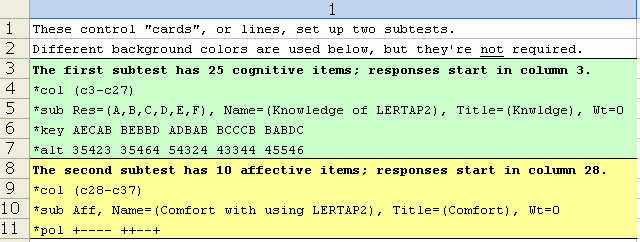Lertap's CCs sheet
The formatting of the CCs worksheet is relatively "ad hoc" when compared to the formatting of the Data worksheet. For example, there's no requirement to have rows with header information.
We almost always include comments in our CCs sheets, rows which remind us what we've done, and when. We sometimes even add some sort of colour coding to our CCs worksheets, as shown below:

The CCs sheet above has four rows with comments: rows 1, 2, 3, and 8. Any row which does not begin with an asterisk is considered to be a comment.
We also like to use a fixed-pitch font, such as Courier New, with the CCs worksheet. This makes the information in the CCs cards line up, as seen above in the *key and *alt cards.
Lertap only looks at the first column of the CCs sheet; any information found in subsequent columns is ignored.
When Lertap finds a CCs row whose first column is empty, it thinks it's come to the end of the CCs lines, and reads no more. This can be handy -- we sometimes enter a single *col card in the CCs worksheet, followed by a blank row. At other times, we'll step into a CCs sheet, and insert a blank row after the *col card. We do this as we know that this will get Lertap to make its Freqs report, but nothing else. Maybe with time you'll come to like the Freqs report as much as we do: it provides a quick, no-frills look at our data. We use it to rapidly get a glimpse of how people answered our questions, and to see if some errors may have arisen whilst processing the data. For example, if the items in our test used the default response codes of (A,B,C,D), we'd be surprised to find Freqs reporting it found an E as one of the item responses.
About here we again insert a critical note regarding response codes (this same message may be found under the Cognitive CCs topic). As all readers know, the Data worksheet contains item responses. In the case of cognitive tests, it is common for item responses to be coded as letters, such as the set {A,B,C,D}. For affective items, {1,2,3,4,5} is a popular response code set. If we look down the columns of the Data worksheet, these response codes are what we see -- "but of course", you might say. And well enough. But: what sometimes happens is that users mis-match the codes found in the Data worksheet with the codes found in a *sub card's Res= declaration. For example, if the Data worksheet shows responses as being from the set {A,B,C,D}, and if Res=(a,b,c,d), there will be a crash -- the Res= declaration is wrong -- the Data worksheet uses upper-case letters.
Now, item responses can be just about anything. The answers to cognitive items can be coded as digits; the answers to affective items may be coded as letters. If letters are used, they may be upper case, or lower case. But in all cases, the Res= declaration has to be "fair dinkum"; if the Data sheet uses lower-case letter, then so must the Res= declaration.
Finally, remember the default Res= assignments. For cognitive tests, the default is Res=(A,B,C,D). For affective tests the default is Res=(1,2,3,4,5). If a *sub card has no Res= declaration on it, these default settings are assumed.
